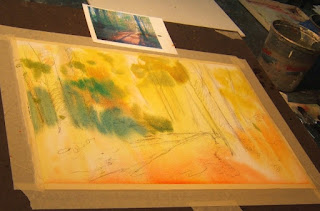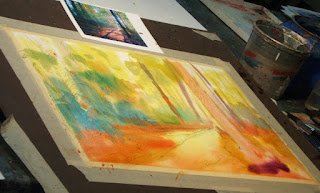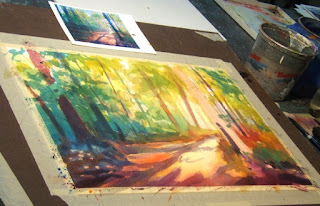My 3-day workshop with Christopher Leeper has ended. I am tired, but happy. I feel I learned a lot and what I learned I can incorporate into things I paint plus I can expand into more landscapes with the knowledge. At least, I hope that is what happens! If I don't do it, it won't be the fault of Chris, who shared so much good information with us all. And while we were learning, we were having fun with lots of stories and laughs shared throughout the workshop days. I gained 4 pounds - how did that happen?? - so now it's back to the regular routine to get those pounds back off. Hey, when you have donuts and pastries each morning with your coffee and pizza for lunch, what are you gonna do? ha ha
Chris did this demo for us the 2nd day, creating a beautiful glowing autumn forest scene.
Again, he began by laying down lots of warm yellows and golds before putting other colors in.
One thing I learned about painting all the foliage and trees = if your trees are going to be darker than the foliage around them, just go ahead and run the first colors over the tree trunks - no need to cut around them and it ties the painting together better than cutting around things. Chris said, "Don't think in words. Words like Tree, Rock, Stream, Building. Think in shapes and values and tie those shapes and values together cohesively to have a better painting." Excellent advice and it ties in with the loose way you put the paint down when you begin your painting.

After the warms are in, then put in your cooler colors over them. Remember - blue and yellow make green so use lots of blues, not just one or two.
Chris likes to start with "bold, obnoxious phthalo blues and greens" and then knock them back by adding other colors to them - he never uses a color straight out of the tube without adding another color to it.

Creating the glow in the woods is about color, yes, but it's mostly about value. Chris described himself as a value painter, not a colorist.

When painting a landscape, try for asymmetry and establish your big planes/shapes right away. Make as many connections as you can that aren't necessarily related by subject = if you see shadow shapes moving across tree trunks, grasses, etc., then paint them that way without thinking, tree trunk, grass, etc.
Chris puts in his "sun colors" early on but not with a complete wash over the whole paper.
Here are some more 1/8 sheet exercises done - with no drawing, just using the brush to draw the shapes. I'm not going to criticise these - they are what they are!
More to come tomorrow to finish up.
Chris did this demo for us the 2nd day, creating a beautiful glowing autumn forest scene.
Again, he began by laying down lots of warm yellows and golds before putting other colors in.
One thing I learned about painting all the foliage and trees = if your trees are going to be darker than the foliage around them, just go ahead and run the first colors over the tree trunks - no need to cut around them and it ties the painting together better than cutting around things. Chris said, "Don't think in words. Words like Tree, Rock, Stream, Building. Think in shapes and values and tie those shapes and values together cohesively to have a better painting." Excellent advice and it ties in with the loose way you put the paint down when you begin your painting.

After the warms are in, then put in your cooler colors over them. Remember - blue and yellow make green so use lots of blues, not just one or two.
Chris likes to start with "bold, obnoxious phthalo blues and greens" and then knock them back by adding other colors to them - he never uses a color straight out of the tube without adding another color to it.

Creating the glow in the woods is about color, yes, but it's mostly about value. Chris described himself as a value painter, not a colorist.

When painting a landscape, try for asymmetry and establish your big planes/shapes right away. Make as many connections as you can that aren't necessarily related by subject = if you see shadow shapes moving across tree trunks, grasses, etc., then paint them that way without thinking, tree trunk, grass, etc.
Chris puts in his "sun colors" early on but not with a complete wash over the whole paper.
Here are some more 1/8 sheet exercises done - with no drawing, just using the brush to draw the shapes. I'm not going to criticise these - they are what they are!
More to come tomorrow to finish up.



10 comments:
Interesting technique and I'm grateful to you for sharing the information.
Hi Rhonda. For a "value" painter, Chris certainly uses some very lush colors - love it! Thank you so much for posting some of his steps in the process.
Rhonda, thanks for sharing. Looks great.
It sounds like you had a great time and certainly looks very interesting from the photos. Will you be using these techniques in your pear series?
How does it feel to know that you organised such a good workshop?
Rhonda lucky you, looks as though you had a great time. Thanks for introducing us to Christopher Leeper and showing us what you learnt with him. It's all fascinating stuff. I'm off to look at more of his work now. BTW I'm really looking forward to reading your next post about this too. Thanks again.
What lovely tips! I like that his blues do not get lost in the earlier yellow wash too. Your pieces are fine, Rhonda, and I really like that second piece with the old trees in the water.
Glad you all enjoyed reading my bits and pieces from the workshop :) Kathryn, Chris says he's a value painter but also a primary color painter because there are not a lot of earth tones on his palette - he makes his yellow ochres and burnt siennas and such from the primaries on his palette, which are pretty luscious!
Lisa, not sure if I would use this one my pears - but it's worth trying! And I haven't rested enough yet to feel proud of myself for organizing workshop - I think I'm just glad I don't have to take care of 20 people again today! ha ha
Do check out Chris' work and his workshops - he is located in northeastern OH - about 5 hours from Cincinnati - and does workshops and teaches in his studio.
Thanks so much, everyone, for the comments.
Rhonda - it sounds like you had a wonderful workshop - thanks for sharing. Looking forward to your lovely landscapes!!
Hello Rhonda:) I already got the feeling that I learn only by reading your post:) And you had 3 days!!
Love the things you did, you are a great student I think. Thanks for sharing:)
Thanks so much, Debbie and Renate. Renate, you are too kind, especially after seeing my attempts! ha ha
Post a Comment